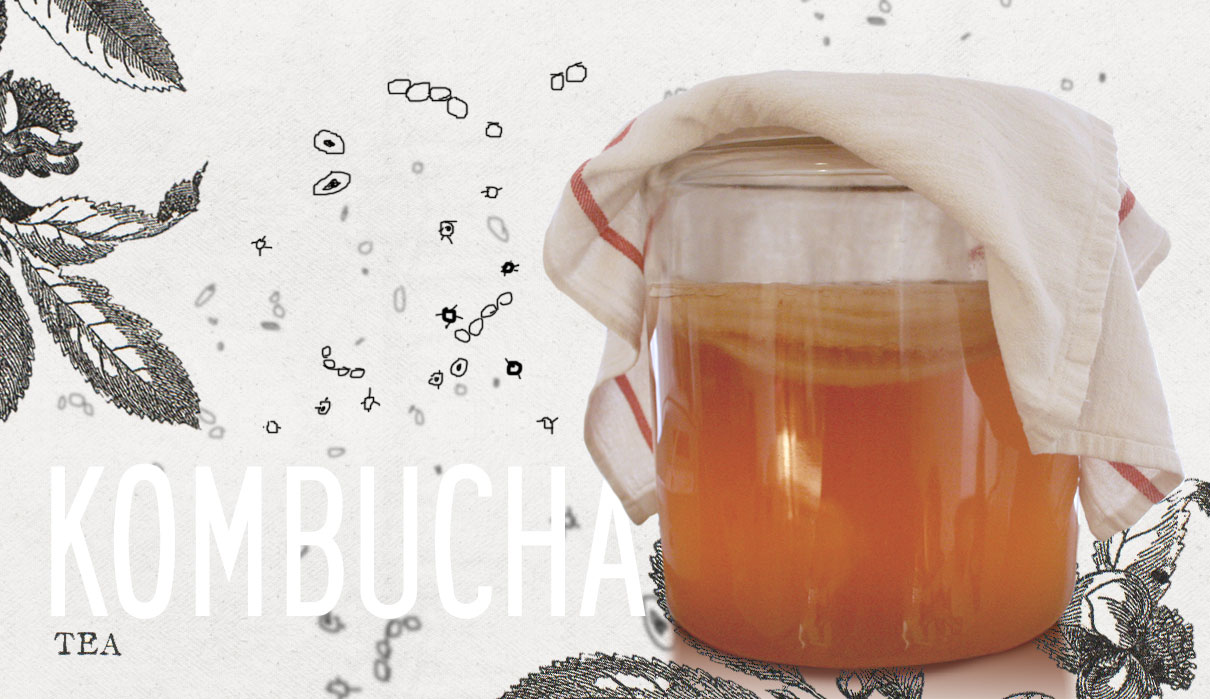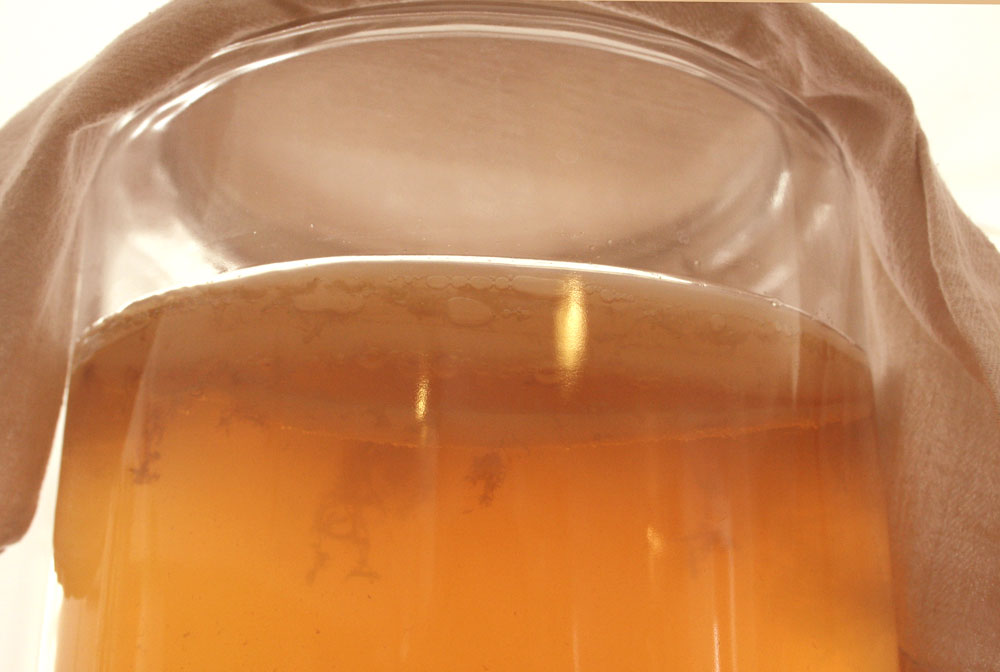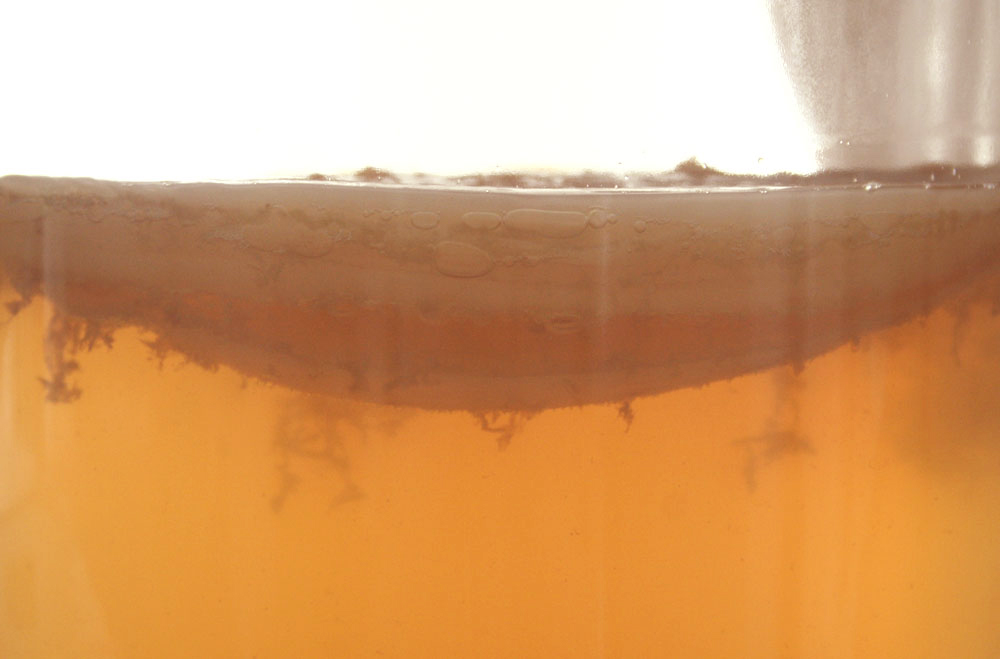Homebrewed Kombucha: Tips and Thoughtful Advice

Thanks to our brother-in-law, we got hooked on kombucha a few months back. And thankfully, our last batch just wrapped up its 10-day ferment. We didn’t time our previous batch with our vacation which resulted in a a short, yet torturous, kombucha-less existence upon our return. Ha! But in all seriousness, this stuff is really good, despite looking like an alien baby floating in formaldehyde.
If you are unfamiliar with kombucha, it’s a naturally effervescent beverage created by fermenting black tea using a SCOBY (Symbiotic Culture of Bacteria and Yeast) for about 7-10 days. The resulting beverage can then be flavored in a myriad of ways, with berries, flavored tea, or ginger (our personal favorite.) It’s can be a bit on the acidic side, and is usually served cold in order to retain the health-benefitting properties.
One of the reasons we started making kombucha is because it’s a natural probiotic. And if you haven’t heard of probiotics yet, you should definitely start looking into it. Contrary to common belief, not all bacteria is bad. Yes, there are dangerous ones that can absolutely kill you and make you sick. But when people talk about “gut bacteria” it’s usually of a different sort. Humans need bacteria in order to survive. The bacteria in our guts keeps us healthy, and due to many factors – environmental, dietary, lifestyle, the over-use of antibiotics, etc. – the balance of bacteria in the gut can get thrown off, which can make us sick. Probiotics help to restore the balance of good bacteria, resulting in better overall health. There are probiotic supplements, but health benefits can be achieved by consuming foods and drinks that have these same properties, many of which are fermented foods. I’m no scientist, but it’s no wonder that cultures around the world and throughout history have some sort of fermented dish that is considered a staple of their cultural diet.
If you want to read more about the benefits of bacteria, here is a great article by Michael Pollan: Some of my Best Friends are Germs »
Though Andrew and I are relatively new to the kombucha-game, we have a brewing process down that’s been working great, thanks to the advice from our brother-in-law, combined with Andrew’s extensive research abilities, and the guidance of fermentation guru, Sandor Ellix Katz through his book “The Art of Fermentation”.
For an in-depth explanation and a step-by-step process to making your own kombucha, you can read here an excerpt from Katz’ book, “The Art of Fermentation” »
Because the kombucha making process is very open to interpretation and experimentation, it’s always interesting to learn how others are tinkering with their ferments. So, naturally I reached out to another kombuch-loving mama to pick her brains on her experience and techniques.
Kombucha Q+A
with Jeanette Kobak-Tartaglia, baker, chef, & contributor to the food blog Chowbacca!
How did you get into making kombucha and how long have you been brewing your own?
I was first introduced to kombucha about 6 years ago by a friend of mine who started selling it at her all vegan cafe. I didn’t know the full scope of exactly what (or how awesome) it was, but I gave it a try and liked it.
I’d been having some auto-immune issues that, to my surprise, seemed to ease up after drinking some, so I was hooked pretty quickly. I’d have her order me cases of GT’s, which even at a wholesale price was getting expensive. I’d also run out for long periods of time and have auto-immune relapses more frequently without it.
I’m naturally curious about all things food, so I did some research to see how doable making it myself would be. Four months later, I had a large, scary blob floating at the top of a mason jar, full of what was previously simply sweetened black tea with a few cups of store bought kombucha added. My first few attempts at a palatable kombucha were a complete flop, but after some time and lots of patience, it improved.
If someone doesn’t know anyone who has a starter to share, are there places you recommend a person get theirs from? How do you tell if a SCOBY is good quality? What should you be looking for?
There are plenty of places to find a kombucha SCOBY online. I have found a few groups on Facebook whose members are more than happy to ship their extra SCOBYs to a new home for just the price of shipping. Fermenters Kitchen is my favorite group. You can also look into Cultures for Health. Although, I do not have any personal experience with that company.
If you are patient, I recommend growing a SCOBY yourself. It’s really amazing to watch one form the very beginning. A good SCOBY is simply one that continually produces kombucha. They are living organisms so they will all look different and take on different qualities. The color of a healthy SCOBY can very from white to brown, depending on the kind of tea it is in.
Things to look for to determine if a SCOBY is healthy is, first off, no mold! If it’s been contaminated with mold, even a little bit, it must go out to compost or in the trash. Another thing to look for is if the main SCOBY (or the Mother) is creating new SCOBYs. That is the best sign that it’s healthy.
My family has been using organic black tea and adding ginger to the ferment, do you have any combinations that you recommend?
I try to keep it simple. For the initial ferment, I use black tea as well. I do not add anything else to this first ferment – just tea, sugar and the SCOBY. When I do decide to flavor it, I do so with a second anaerobic ferment [anaerobic means it’s sealed, not open to oxygen]. I keep it simple by using frozen berries (because fresh berries have a much higher chance of introducing mold spores), ginger or simply an organic flavored herbal tea bag and let it sit at room temp for 24 hours. The naturally occurring sugars in the fruit create a nice carbonation if sealed properly.
When doing the second anaerobic ferment, if you are using glass jars do you have to take any precautions to prevent breakage or do you not recommend using glass for the anaerobic ferment?
I’ve used mason jars without having any explosions so far. I do pay attention to it though and burp them once during the secondary ferment and get them under refrigeration within 12-16 hours.
Our ginger has a tendency to stick to our SCOBY, is that okay for it to just hang out there? We’ve heard of people who rinse their SCOBY to get all the hanging stuff off, should we be doing that?
I’ve never heard of using ginger in a first ferment along side a SCOBY. But I would remove any that gets stuck. As the SCOBY grows the ginger may get trapped between the layers and become an attractive place for mold to grow.
The hanging stuff on a SCOBY is actually yeast, a biproduct of the fermenting process. I do remove some of it as I have read too much yeast may block the SCOBY fermenting the tea. I just recently started a kombucha yeast sourdough starter!
Any tips for people want to give it a try and what is your process?
I first started out doing single batches in mason jars, that made things a lot more difficult than it needed to be. I recommend using a large ceramic crock or large glass sun tea jar with spigot and doing a continuos brew.
I’ve read so many things about how beneficial kombucha is for a persons health, and just fermented foods in general, is there an optimal time of day for drinking kombuca to reap the maximum benefits? And is there a limit to how much a person should drink a day?
Kombucha is a pretty awesome probiotic. My family drinks it all day long. If a person has never tried or is new to kombucha (or other fermented food) I suggest introducing just a few tablespoons a day to start with while your body adjust to the probiotics.
What type of sugar do you use and have you tried different kinds? Does that affect the SCOBY?
I use organic cane sugar. The SCOBY really doesn’t know the difference it will eat all sugars so I try to keep it simple and cost effective.
Thanks to Jeanette for her insight and tips! Are you a kombucha homebrewer? If you have any tips, advice, or experiments you’d like to share, I’d love to hear them!
About Jeanette

Jeanette K Tartaglia has been a ‘knife-for-hire’ for over 20 years. She has done recipe development for restaurants and cafes, she’s been a personal chef and caterer and is currently working as a contract baker. Her love of all food has taken a sharp turn leading down a path of real, healing food since dealing with personal autoimmune disorders. When she isn’t developing recipes, or baking pastries and sourdough, she blogs for Chowbacca! and enjoys fermenting foods and brewing beer. She’s passionate about teaching her four kids about food and together experimenting with cooking and organic gardening.


Barb Mahdinec - May 1, 2014 12:04 am
Great read! Must try! Have autoimmune issues and it might help me too! Take probiotics but this sounds better! Need to try it somewhere first.
Crystal - May 1, 2014 12:23 am
Barb, if you want to give it a try we always have some on hand. We can also give you a starter if you want to try brewing your own!